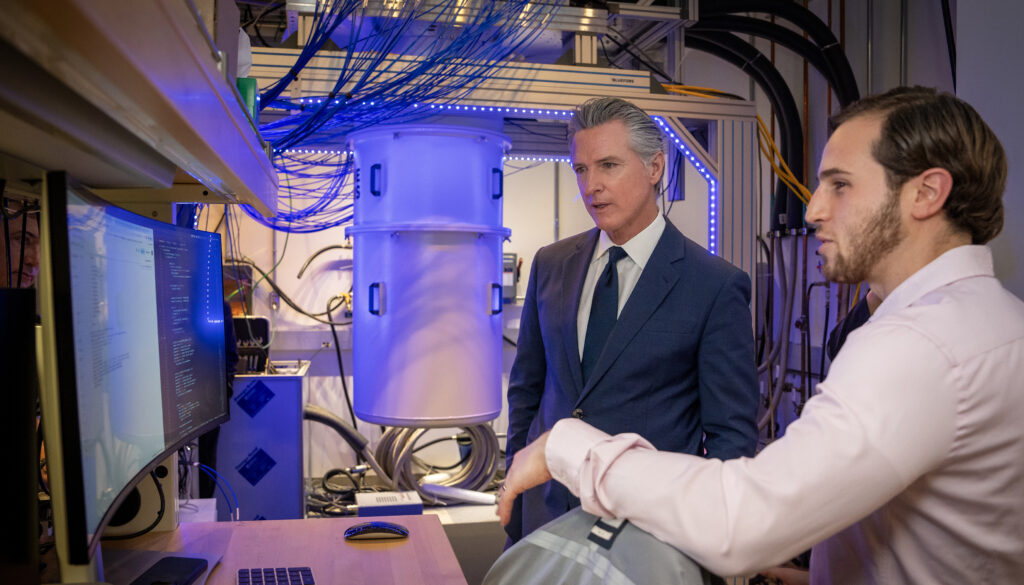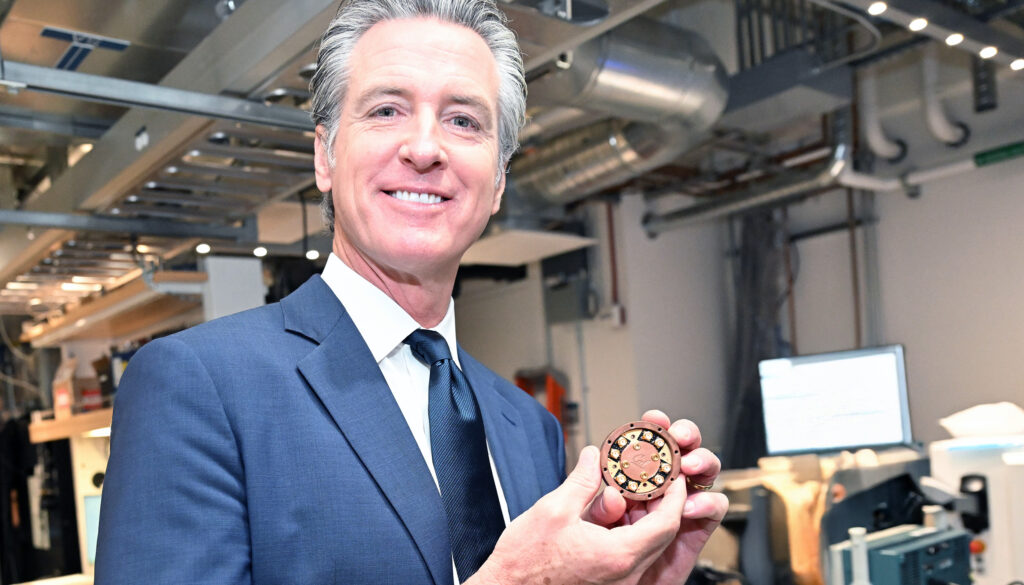Visiting UC Berkeley's Campbell Hall today, Gov. Gavin Newsom signed a bill to create "quantum innovation zones" across the state, positioning the campus as a leader in the race to establish California and the Bay Area as a center of an emerging economy.
The innovation zones will leverage California's leading edge in quantum computing and research, stimulating the economy and generating jobs in what is expected to be a trillion-dollar-plus industry.
Newsom also spoke to reporters and toured three quantum computing labs at Berkeley - among the many quantum research endeavors on campus.
"It was amazing to walk in the labs downstairs and to see the world here at UC Berkeley," Newsom said. "… I'm very proud to be part of this inclusive community here at UC Berkeley and the remarkable ecosystem that's been built up over the course of decades - to be here with people that aren't just the best and the brightest, but truly represent the best and the brightest around the globe."
Quantum computers work a lot differently than today's digital computers. The quantum bits, or qubits, in a quantum computer are entangled in a way that allows some types of computations that are not possible with a digital computer. But the quantum economy extends beyond computers to other types of applications, including secure telecommunications and new types of sensors that rely upon the quantum nature of particles and light.

Assembly Bill 940 tasks innovation zones with identifying projects and programs that best utilize public dollars to "support the development of the quantum computing economy." The bill was introduced by Assemblymember Buffy Wicks (D-Berkeley) after discussions with Berkeley faculty members Steve Kahn, dean of physical and mathematical sciences, and Irfan Siddiqi, who chairs the physics department.
"I had lunch with the chancellor and some of the research folks from Cal about a year and a half ago, where they said to me, 'We're going to lose out on quantum unless we do something,'" Wicks said at Friday's news conference. "We have the academic research to support these newer technologies. We have a private sector that wants to invest in this. We need the state to have skin in the game, and we need the state to demonstrate that we're … actually going to lead on quantum research here in California."
"This isn't just (for) San Francisco, Los Angeles. This is technology that's going to benefit communities far and wide of all shapes and sizes and colors and socioeconomic experiences," Wicks added. The legislation "signed today is really California planting their flag to lead this industry."
Chancellor Rich Lyons thanked the lawmakers. "Berkeley is thrilled and honored to be the launchpad for 'Quantum California,' the state's effort to support the best research facilities, to foster the quantum industry and build the quantum workforce. The promise of this science is exciting. We can envision its benefits in cybersecurity, drug discovery, new materials, scientific simulations and other massive computing problems."

Keegan Houser/UC Berkeley
He mentioned that the campus is creating a "Quantum Nexus" that will open this fall in the old Masonic Temple in downtown Berkeley. It will be a place for scientists, students, policymakers and industry leaders to convene and collaborate around quantum science.
"We see this as crucial to ensuring the partnership necessary to establish quantum information as the engine for the next major technical revolution in California and around the world," Lyons said. "The discoveries that happen here on the Berkeley campus become the technologies, goods and services that advance the health, well-being and security of the American people."
Upon arriving at Campbell Hall this morning, Newsom was whisked into the belly of Campbell Hall, the home of numerous campus labs focused on quantum computing. Siddiqi gave the governor a tour of his lab, handing him a sample quantum processor a centimeter on a side that includes about a dozen 'qubits' - the quantum bits at the core of quantum computers.
"That's it? That's literally it?" Newsom said in amazement, as scientists and graduate students from Berkeley and Berkeley Lab gathered round to share their research.
"This bill lowers the barriers for companies to stay in California," Siddiqi said, "leveraging all the quantum resources in the state,
Siddiqi, who focuses on solid-state qubits, said that collaboration could give rise to "Quantum Valley," akin to Silicon Valley.
Materials scientist Alp Sipahigil, assistant professor of electrical engineering and computer sciences and of physics, showed Newsom his research to define the "next generation of quantum computers." He also emphasized his efforts to devise a course that marries physics with engineering. Such courses are essential to "training lots of people competent in chip design and the principles of quantum mechanics" as part of a future quantum workforce.

Keegan Houser/UC Berkeley
Newsom spoke with many of the students and researchers in the labs. Amid a tangle of overhead wires in the lab of Dan Stamper-Kurn, professor of physics, the governor learned about the need to cool single-atom qubits down to 10 millionths of a degree above absolute zero to make them work.
"Science fiction is now real," Stamper-Kurn told him.






